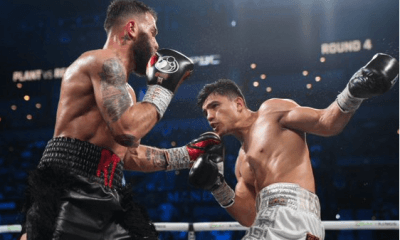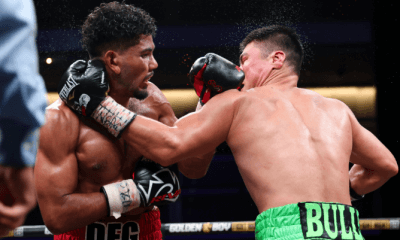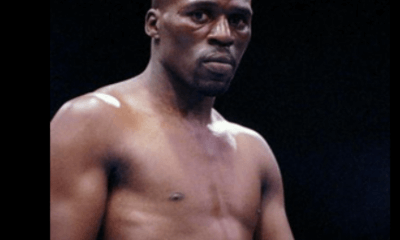Featured Articles
Deontay Wilder’s Lame Excuse Gets No Brownie Points for Originality

Deontay Wilder’s Lame Excuse Gets No Brownie Points for Originality
Deontay Wilder had 43 pro fights under his belt before he suffered his first pro loss. But the Alabama knockout artist didn’t just lose to Tyson Fury in their rematch. In the court of public opinion, he fell from grace with a thud.
Knocked down twice before referee Kenny Bayless waived the fight off in the seventh stanza, the Bronze Bomber initially blamed his woeful performance on the elaborate costume that he chose for his ring walk. Reportedly costing $40,000, the rhinestone-studded outfit – which didn’t stand out or photograph well in the dark arena – was designed, said Wilder, to celebrate Black History Month, but it’s a fair guess that most folks wouldn’t have made that connection. This reporter’s first impression was that Wilder got his months mixed up and thought that Halloween fell in February.
The costume, said to weigh 40 pounds, was cumbersome: “I didn’t have no legs from the beginning of the fight,” Wilder told Yahoo’s Kevin Iole. “In the third round, my legs were just shot all the way through.”
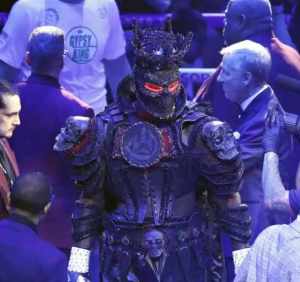
Finding excuses for a bad outing is old hat in sports, especially boxing, and the list of excuses is long. In blaming his performance on his ring costume, Deontay Wilder invented a new category.
He should have left it at that, but this past Saturday, in a rambling and somewhat incoherent two-minute video, Wilder doubled-down with a hackneyed excuse, alleging, among other things, that his water was spiked with some sort of muscle relaxer. He pointed the finger of blame at co-trainer Mark Breland.
The “someone messed with my water” accusation is hoary. It likely first cropped-up in the bare-knuckle era.
James J. Jeffries, who won the world heavyweight title from Bob Fitzsimmons, was undefeated when he retired in 1904. Reluctant to return to the ring, he eventually succumbed to the fervent plea to come back and restore the title to the white race.
Jeffries was favored over Jack Johnson when they met at Reno in 1910 in the first Fight of the Century, but Big Jeff was a shell of his former self and won nary a round until the bout was stopped in the 15th.
In hindsight, the outcome was predictable. In retirement, Jeffries’ weight ballooned to 315 pounds and after trimming down he still had plenty of rust to shed after being out of action for almost six full years. But immediately there was talk that Jeffries had been drugged, talk that he encouraged. “It would have been impossible for me to break down in the condition I was in, so suddenly, unless someone got to me in an underhanded way. That I was tampered with is a certainty,” he said.
The famous sportswriter Robert Edgren “confirmed” the persistent rumor in a story written for Liberty magazine in 1926, but put a new spin on it. According to Edgren, it wasn’t Jeffries’ water that was spiked, but rather a cup of tea that Jeffries consumed after being conned into thinking that his wife had made it for him. “They gave him enough (sedative) to knock out an elephant,” wrote Edgren, a longtime pal of Jim Jeffries.
Flash forward to 1995 and one finds George Foreman making a similar accusation regarding his iconic 1974 “Rumble” with Muhammad Ali. In his autobiography “By George,” co-authored with Joel Engel, Foreman accused his former trainer/manager Dick Sadler of dehydrating him and said that Sadler may have also tainted his water. He further alleged that Sadler had taken $25,000 from him to give to referee Zack Clayton as an insurance policy to make certain Clayton would not disqualify him. He conceded that he did not know if the referee received the under-the-table payment or if Sadler had kept the money for himself.
Foreman reiterated the part about the water in his 2007 book “God in my corner,” his first of two collaborations with Ken Abraham. “I almost spit it out,” Foreman said. “(I told Sadler), ‘Man, I know this water has medicine in it.’ I climbed into the ring with that medicinal taste still lingering in my mouth.…After three rounds, I was as tired as if I had gone 15.” (Upon hearing this, Muhammad Ali purportedly quipped, “there was worse medicine waiting for him when he got in the ring.”)
Foreman’s 1995 book caused him some flack. Dick Sadler, who had been with Foreman since the advent of George’s pro career – and had worked with other boxers before him, notably Archie Moore – was well-respected in the boxing community. Moreover, it didn’t jibe that Foreman, who replaced Sadler with Gil Clancy following his loss to Ali, rehired Sadler as his lead trainer in 1977 following his loss to Jimmy Young (albeit they would never team up again in an actual fight as Foreman abandoned boxing for the ministry).
When Foreman reiterated his allegation in his 2007 book, there was no backlash whatsoever. By then, Big George had charmed his way into the hearts of millions and to smudge him was tantamount to sacrilege. And Sadler was no longer around to defend himself. He died in 2003 at age 88.
Commenting on Deontay Wilder’s most recent allegation, Kevin Iole used the word heinous.
We get it. Mark Breland, the former Olympic gold medalist and former two-time welterweight champion, is a man of unimpeachable integrity. Throwing him under the bus was contemptible. However….lighten up, Kevin.
Aside from some of Wilder’s homies, it’s doubtful that anyone is giving any credence to Deontay’s bizarre accusations. Breland, who thus far hasn’t seen fit to dignify Wilder’s assertion with a rebuttal — at least not publicly – won’t have trouble finding other fighters to train; his reputation is solid.
Wilder’s frustration may have clouded his judgment. There was a rematch clause in his contract with Tyson Fury, but Fury’s co-managers Frank Warren and Bob Arum found a loophole in the fine print that has enabled them to renege on the deal. Fury will now face someone else when he next steps into the ring – reputedly in London in December with Agit Kabayel in the opposite corner – while Wilder’s career is in limbo.
It has been written that those with a financial stake in Wilder’s career were likely chagrined by these latest developments. We doubt that. It will serve Wilder well to keep his name in the news, even if he comes across as a buffoon. Someday, someone will write the story of his life, an “as told to” book where Wilder will share in the royalties – shucks, fighters of far lesser importance have been the subject of authorized biographies, some even with the backing of strong publishing houses.
When that book is written, it will garner a few more sales if Wilder sticks tight to his conspiracy theories. Just ask George Foreman.
Photo credit: Mikey Williams / Top Rank
Check out more boxing news on video at the Boxing Channel
To comment on this story in the Fight Forum CLICK HERE
-

 Featured Articles3 weeks ago
Featured Articles3 weeks agoThomas Hauser’s Literary Notes: Johnny Greaves Tells a Sad Tale
-
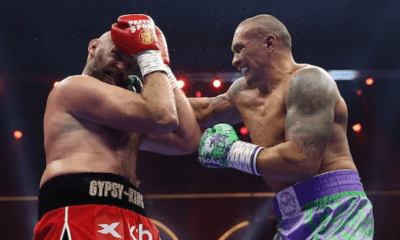
 Featured Articles2 weeks ago
Featured Articles2 weeks agoBoxing Notes and Nuggets from Thomas Hauser
-
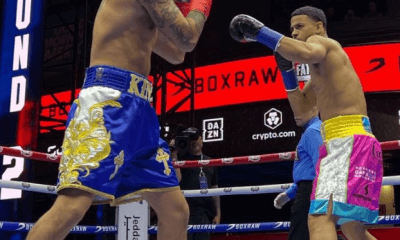
 Featured Articles4 weeks ago
Featured Articles4 weeks agoRolly Romero Upsets Ryan Garcia in the Finale of a Times Square Tripleheader
-
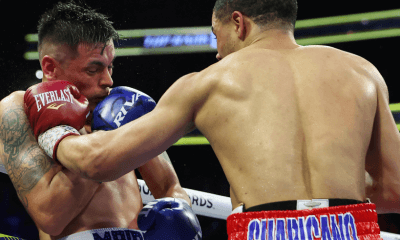
 Featured Articles4 weeks ago
Featured Articles4 weeks agoUndercard Results and Recaps from the Inoue-Cardenas Show in Las Vegas
-
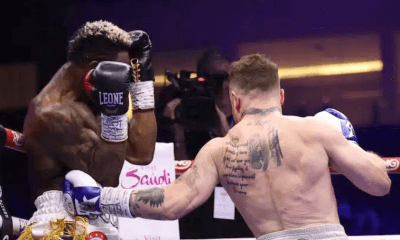
 Featured Articles4 weeks ago
Featured Articles4 weeks agoCanelo Alvarez Upends Dancing Machine William Scull in Saudi Arabia
-
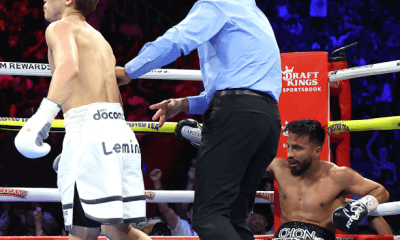
 Featured Articles4 weeks ago
Featured Articles4 weeks agoBombs Away in Las Vegas where Inoue and Espinoza Scored Smashing Triumphs
-
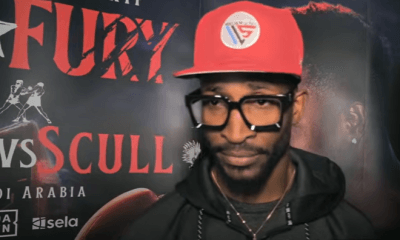
 Featured Articles4 weeks ago
Featured Articles4 weeks agoArne’s Almanac: The Good, the Bad, and the (Mostly) Ugly; a Weekend Boxing Recap and More
-
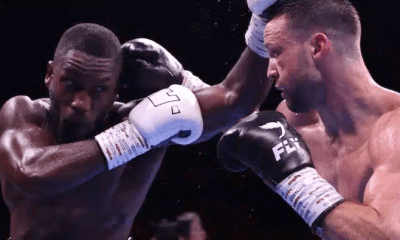
 Featured Articles1 week ago
Featured Articles1 week agoEkow Essuman Upsets Josh Taylor and Moses Itauma Blasts Out Mike Balogun in Glasgow

